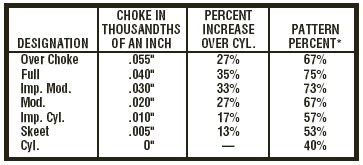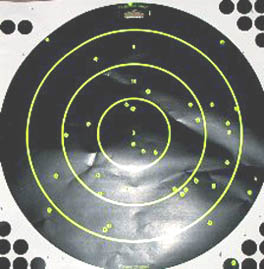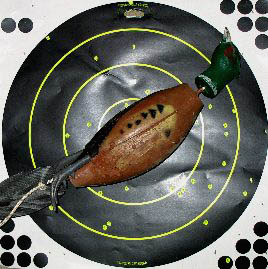|
Patterning for Game Birds It is difficult for all of us to accept that not only are all guns individuals, no two patterns are identical. Just because a choke tube or shotgun barrel is marked "modified" means absolutely nothing in a specific sense. Patterns are performance based, not constriction based. After market choke tube makers sell chokes on the basis of "constriction," but that is misleading. They cannot know the actual amount of constriction, simply because they do not know the inside diameter of your shotgun's bore. More correctly, after market chokes tubes are sold on the basis of their inside diameter. It is our job to measure our barrel's bore, and only the choke tube internal diameter subtracted from our barrel's mic'ed internal diameter can give us the actual amount of constriction. There is a relationship between pattern performance and the constriction of our chokes, but not an exact relationship. Consider the following chart, which is as accurate (or as inaccurate) as most of them:
No chart giving patterns at 40 yards in a 30 inch circle can be exact. This does not take into account the size of the shot, the hardness of the shot, the payload weight, muzzle velocity, the design of the choke itself, or the gauge being discussed. Whoever said the only thing that is predictable about shotguns is that they are unpredictable had it right. We need to start somewhere, though, and the above chart serves that purpose. Percentages do not bag birds, pellets do. So, it is important to look at the number of pellets contained in our shotshell loads. In an ounce of lead shot there are approximately 585 #9 pellets, 410 # 8 pellets, 350 #7 1/2 pellets, 225 #6 pellets, 170 #5 pellets, 135 # 4 pellets, and 90 #2 pellets. It should be clear that to well-populate a pattern takes a lot more #4 shot by weight @ 135 pellets to the ounce than #8 shot @ 410 pellets to the ounce. There are several myths that should be dispelled. One fellow I know claims to take only "head shots" on pheasants using 1-1/2 ounces of #6 shot. It's not easy to miss a pheasant 449 times with a single pull of the trigger, but I guess he manages. A misconception is that with so many pellets, it is hard to miss. After all, just one ounce of #8 shot gives us 410 projectiles. Of course, we do miss. Not everyone runs the skeet field every time, and anyone that claims to come home with as many doves as empty hulls could be taking a bit of liberty with reality. Lethality is a whole different matter. John Brindle claimed that for a 1-1/8 oz. 12 gauge shell to be acceptably lethal on game the pattern must not be larger than about 25 inches across. For the farthest skeet targets the pattern must not be larger than 20 inches in diameter, and for trap about 14 inches across. All of this may seem a bit confusing, but it really isn't. We need to determine the range at which we most often take, or would like to take, our game and go for the optimum pattern at that range, which will likely be about twenty-two inches across. Our pattern size will be smaller inside that range, and become larger and less lethal beyond it. Patterning our guns at the distance we are taking game and determining if a game bird could possibly live through that pattern is a forthright approach. A recent addition to my bird-bagging collection was another Browning B-80 in 20 gauge. After measuring the bore with my set of hole gauges, I discovered it measured about .6205 in., over .003 in. larger than the stated .617 bore. A .003 in. "skeet choke" in this gun would be no constriction, no choke effect at all. I selected a Carlson's extended Sporting Clays .595" tube (marked IM) which puts me in the area I've found to be a good compromise for pheasants with a 20 gauge gun, just under a .020" constriction (assuming good ammo). To verify that this was an adequate choice, I grabbed some Fiocchi 3" 1-1/4 oz. nickel plated "Golden Pheasant" loads and zipped off to the field to see what the pattern looked like at 40 yards. The results are below:
Normally I wouldn't waste a Birchwood-Casey Shoot N'C target for patterning, but since Chuck Hawks is such a great guy (Nothing but the best for a G&S Online article! -Ed.), I've spared no expense. With the help of Rocky the Wonder dog's pheasant dummy, it illustrates (as illustrations should) that no pheasant would likely make it through that pattern without multiple, quickly lethal hits. In fact, there is nowhere inside the 10X area that I can place my palm without covering multiple #5 shot holes. This reveals nothing about how that gun/choke tube/shell combination patterns at 45 or 50 yards, or tells anything about the pattern at 20 or 25 yards. The only way to know what we have at those ranges is to pattern at them. As is, it does show that the Fiocchi Golden Pheasant / Carlson .595 in. extended choke in this B-80 20 gauge gun is an adequate pheasant load at 40 yards. If your personal patterning efforts show that your gun/choke/shell combination delivers multiple hits to the vitals with a pellet size carrying sufficient energy to penetrate through them, you will have the confidence that brings greater success all by itself. When the birds fall dead, there should be no surprise whatsoever except, perhaps, to what you are shooting at. |


